Norwich City, Sheffield United and Aston Villa all have the sizeable task of staying alive in the big, bad Premier League, and none are showing signs of blinking and retreating to a safety first approach. England’s top flight is brutal and unforgiving, we’re told. The way to survive is to dig deep, make your home ground a fortress, become tough to beat and ride a little bit of luck, we’re told. But are this year’s crop going for that traditionalist approach? Well not at all, really. Let’s take a closer look at each.
Norwich City
Norwich had the easiest decision of the three in terms of how to approach this season due to the lack of business done in the summer. They had an approach that obviously worked for them last season, with a certain club in South West London seemingly becoming a cautionary tale for ripping up what got you into the top flight and changing everything (which maybe an unfair caricature, but that’s a discussion for another day). If the worst case scenario happens and Norwich go straight back down, they still have a manager and core of players who have showed previously that they could successfully execute a style of football to a good level in the Championship, so the Canaries would still fancy themselves to challenge for promotion again while reaping the parachute payments. But that’s obviously not Plan A. The real aim is to just keep doing what they were doing last season and trust that it will be enough in the top flight. In terms of analysing how that’s going, a cruel early fixture list with the side having faced Liverpool and Chelsea has skewed things somewhat on the defensive end. Their 1.49 expected goals conceded per game is a 59% increase on last season, but again, fixtures have been tough. What’s more concerning is how across the board the defensive weakness has been. Norwich have been less of a high pressing side this season, as both their average defensive distance falls deeper and they allow the opponents 2.5 more passes in an average sequence before attempting to win the ball back. What we’d expect to see from this is the Canaries to drop off in terms of suppressing shot volume, and that’s what’s happened, as they’ve so far conceded 17 per game instead of last year’s 12. But the flip side of this lower pressing, lower shot suppressing approach is that you’re supposed to form a better defensive shell, make it harder for opponents to get chances in dangerous areas, and restrict the shot quality rather than volume. And that just isn’t happening. The Canaries’ xG per shot conceded has made a small but notable tick up, from 0.080 to 0.087. At Premier League level, through three relatively tough fixtures, Norwich are having a tough time avoiding getting cut open. The lower pressing numbers feel less like a deliberate strategy than simply an inability to exert control over games against superior opposition. 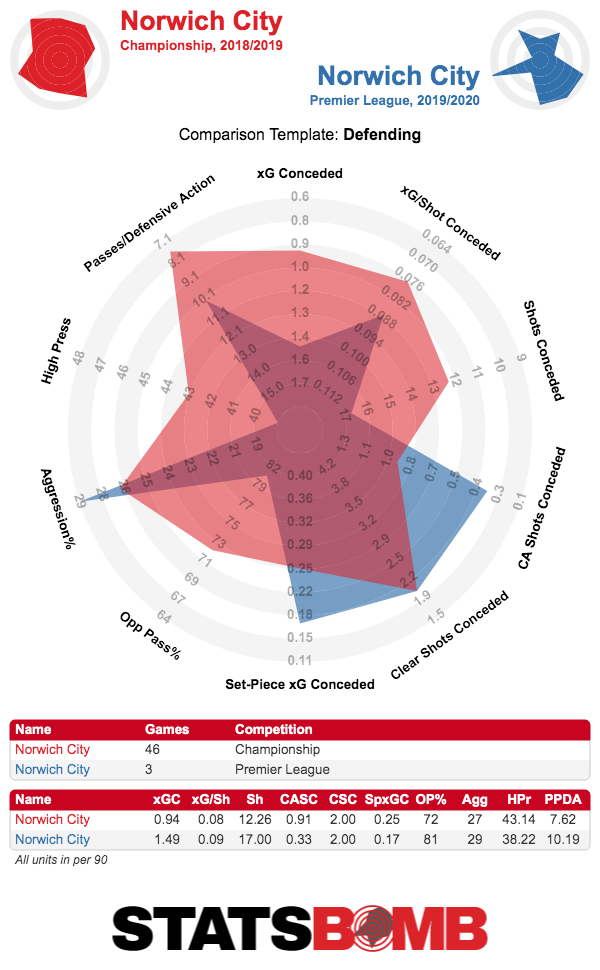 Of course, the good news for Norwich fans has been in attack. Finishing exaggerates the extent to which the side has been “open” so far, with Norwich seeing more goals go in than expected at both ends of the pitch, but it’s still very early. Perhaps Norwich will become a team we typically expect to do this due to an attacking emphasis (see: Liverpool 2016/17 for an example of such a skew), but we’ll have to wait for more data points on that. Regardless, the Canaries having the ninth best attack in the league so far after those games is a genuine accomplishment.
Of course, the good news for Norwich fans has been in attack. Finishing exaggerates the extent to which the side has been “open” so far, with Norwich seeing more goals go in than expected at both ends of the pitch, but it’s still very early. Perhaps Norwich will become a team we typically expect to do this due to an attacking emphasis (see: Liverpool 2016/17 for an example of such a skew), but we’ll have to wait for more data points on that. Regardless, the Canaries having the ninth best attack in the league so far after those games is a genuine accomplishment. 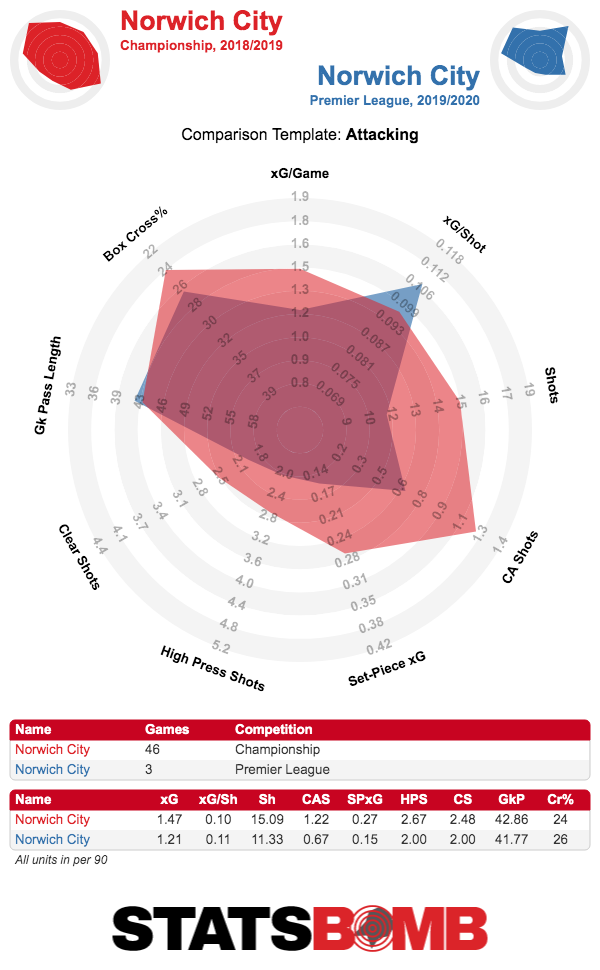 Unsurprisingly, Teemu Pukki is currently smashing xG, with 5 goals scored from 1.9 expected, but even if he returns to a normal finishing rate, if he maintains this volume of chances he should end up with a very good goal return. What’s especially notable is that seven of his twelve shots so far have been assisted by through ballsm with Emiliano Buendía in particular having an eye for such a pass. In a strange way, this might actually be a benefit of Norwich being unable to enforce a pressing game on opponents. As teams push higher and higher into Norwich’s half, space seems to be opening up for such incisive passing, and Pukki has been reaping the rewards. While there would surely be a net gain, better control of the game might make it harder for the team to break so well in the opposition half. If Norwich learn how to exert a press in the Premier League, they might become a little more boring. As it is, this is one of the most entertaining teams in the division to watch as a neutral.
Unsurprisingly, Teemu Pukki is currently smashing xG, with 5 goals scored from 1.9 expected, but even if he returns to a normal finishing rate, if he maintains this volume of chances he should end up with a very good goal return. What’s especially notable is that seven of his twelve shots so far have been assisted by through ballsm with Emiliano Buendía in particular having an eye for such a pass. In a strange way, this might actually be a benefit of Norwich being unable to enforce a pressing game on opponents. As teams push higher and higher into Norwich’s half, space seems to be opening up for such incisive passing, and Pukki has been reaping the rewards. While there would surely be a net gain, better control of the game might make it harder for the team to break so well in the opposition half. If Norwich learn how to exert a press in the Premier League, they might become a little more boring. As it is, this is one of the most entertaining teams in the division to watch as a neutral.
Sheffield United
While things were tough straight out of the gate for Norwich, the fixture list handed Chris Wilder’s side a much kinder introduction to the Premier League. A win at home to Crystal Palace, a draw away at Bournemouth and a defeat to a visiting Leicester seems a reasonable start in terms of results for the aim of staying up, and the numbers look solid as well. The Blades’ defensive distance has actually risen a modicum from last year, and looking at the defensive activity map, they’re a pretty full throttle pressing side (with a clear lean to one side, but that’s something that could easily even out after a few more games). 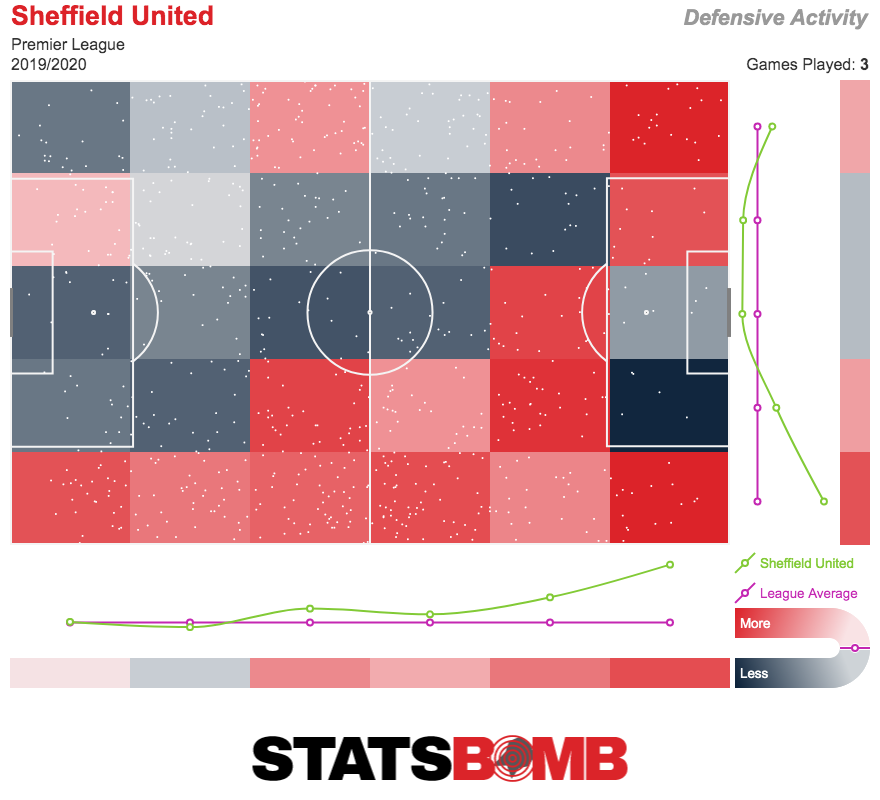 As it should be with a press slightly higher, the shot volume conceded has dropped off a little while the quality of those chances has risen a smidgen. Otherwise it all looks the same as last season on the defensive end. Sheffield United have yet to face the real elite of the Premier League, but the three teams they’ve played so far are still a clear step up from Championship opposition, so this is an obvious positive sign.
As it should be with a press slightly higher, the shot volume conceded has dropped off a little while the quality of those chances has risen a smidgen. Otherwise it all looks the same as last season on the defensive end. Sheffield United have yet to face the real elite of the Premier League, but the three teams they’ve played so far are still a clear step up from Championship opposition, so this is an obvious positive sign. 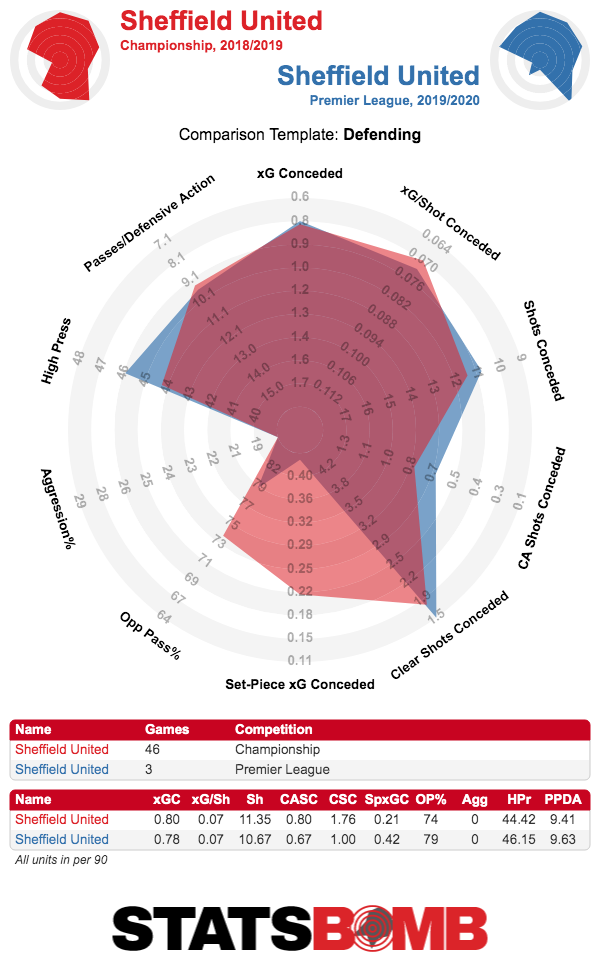 The attack is down a chunk, at 1.13 xG per game versus last season’s 1.31, but you can’t have it all. What’s worrying is that this looks even worse when you just look at chances from open play. United were not amazing in this phase of the game last season, putting up just shy of an expected goal a match from open play. Fortunately, they beat xG here by around 11 goals, but it would be awfully optimistic to expect them to do that again. We might just have to accept that the Blades will not be a team that creates a lot of chances. The better news is that the shot quality, both from open play and set pieces, is holding up in the step up to the top flight. In the very early signs, this might be a team that mostly relies on narrow margins to win football matches. Sheffield United feel like something of a contradiction. They have a squad of players overwhelmingly from the UK and Ireland, managed by a veteran of EFL and non-league football finally getting a chance in England’s top flight, but they play a tactically innovative system. They have a statistical profile of a team that keeps things tight at the back first and foremost, but by pressing high rather than sitting deep. They’re doing it their way, and are a welcome addition to the Premier League for it.
The attack is down a chunk, at 1.13 xG per game versus last season’s 1.31, but you can’t have it all. What’s worrying is that this looks even worse when you just look at chances from open play. United were not amazing in this phase of the game last season, putting up just shy of an expected goal a match from open play. Fortunately, they beat xG here by around 11 goals, but it would be awfully optimistic to expect them to do that again. We might just have to accept that the Blades will not be a team that creates a lot of chances. The better news is that the shot quality, both from open play and set pieces, is holding up in the step up to the top flight. In the very early signs, this might be a team that mostly relies on narrow margins to win football matches. Sheffield United feel like something of a contradiction. They have a squad of players overwhelmingly from the UK and Ireland, managed by a veteran of EFL and non-league football finally getting a chance in England’s top flight, but they play a tactically innovative system. They have a statistical profile of a team that keeps things tight at the back first and foremost, but by pressing high rather than sitting deep. They’re doing it their way, and are a welcome addition to the Premier League for it.
Aston Villa
Stick or twist wasn’t a question that Aston Villa were really able to ask themselves. The reliance on loans in the season that got them promoted meant that the squad would need reshaping. Villa did it the expensive way, and in theory their approach felt fairly scattershot and without a clear idea of what the team would be. Is there news in the early numbers that can refute this? To an extent, yes, there is. Villa currently have a negative expected goal difference, but that includes a game in which Spurs threw out the full battering ram as they spent most of the game desperately searching for an equaliser and winner. Since then, they’ve run two very close fought games against Bournemouth and Everton and picked up a fair three points. Villa’s xG numbers are almost identical to Norwich’s, though the schedule has been slightly softer. 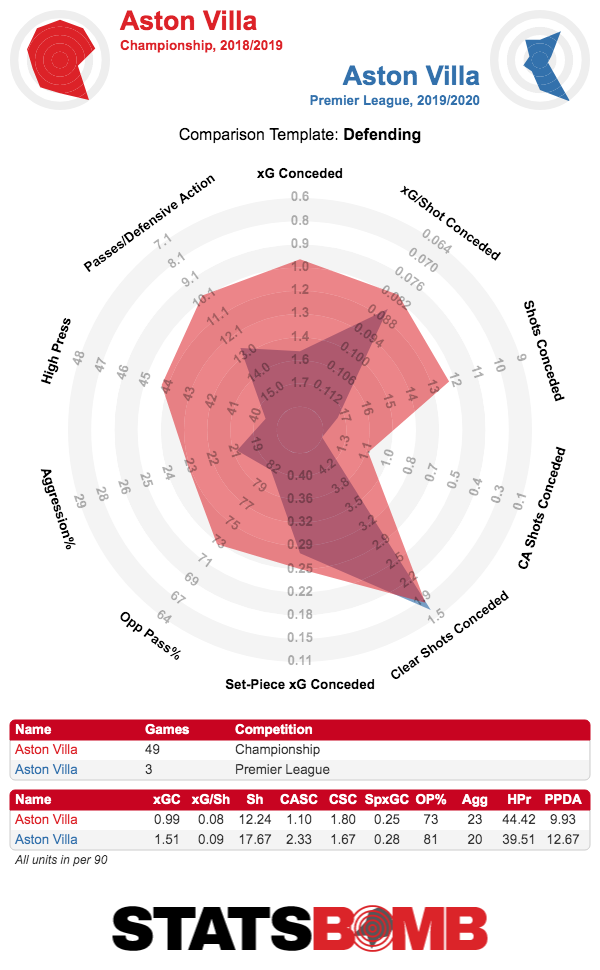 Dean Smith’s reputation at Brentford and now Villa has been of a manager who struggles to coach a solid defence while playing exciting football at the other end, That has not traditionally been seen as the way to keep a club from relegation, though a higher variance style should mean fewer draws. In recent years, too many games where the points were shared proved the death knell for Middlesbrough and West Brom, so it’s possible that Villa could avoid that fate with both more wins and losses. So far in the numbers, they’ve translated their attacking output into the top flight fairly well (1.26 xG per game against 1.33 last year), while having a 53% increase on the defensive side. So we’re taking an already fairly open side and doubling down on that. Goalkeeper Tom Heaton had an excellent reputation in a very secure defensive system at Burnley, so this will really test him in ways we haven’t seen in the Premier League. Villa look the least cohesive of the three promoted teams and the most likely to just crash and burn, but could also have the highest ceiling of these sides. Villa Park will not lack for incident this season. Header image courtesy of the Press Association
Dean Smith’s reputation at Brentford and now Villa has been of a manager who struggles to coach a solid defence while playing exciting football at the other end, That has not traditionally been seen as the way to keep a club from relegation, though a higher variance style should mean fewer draws. In recent years, too many games where the points were shared proved the death knell for Middlesbrough and West Brom, so it’s possible that Villa could avoid that fate with both more wins and losses. So far in the numbers, they’ve translated their attacking output into the top flight fairly well (1.26 xG per game against 1.33 last year), while having a 53% increase on the defensive side. So we’re taking an already fairly open side and doubling down on that. Goalkeeper Tom Heaton had an excellent reputation in a very secure defensive system at Burnley, so this will really test him in ways we haven’t seen in the Premier League. Villa look the least cohesive of the three promoted teams and the most likely to just crash and burn, but could also have the highest ceiling of these sides. Villa Park will not lack for incident this season. Header image courtesy of the Press Association
